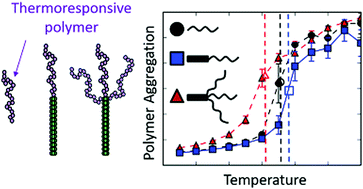Effect of conjugation on phase transitions in thermoresponsive polymers: an atomistic and coarse-grained simulation study†
Abstract
Using atomistic and coarse-grained molecular dynamics (MD) simulations, we explain the shifts in lower critical solution temperature (LCST)-like phase transitions exhibited by elastin-like peptides (ELPs) upon conjugation to other macromolecules (e.g. collagen-like peptides or CLPs). First, using atomistic simulations, we study ELP oligomers with the sequence (VPGFG)6 in explicit water, and characterize the LCST-like transition temperature as one at which the ELP oligomers undergo a change in “hydration state”. In agreement with past experimental observations of Luo and Kiick, upon anchoring ELP oligomers to a point to mimic ELP oligomers conjugated to another macromolecule, there is an apparent slight shift in the transition temperature to lower values compared to free (unconjugated) ELP oligomers. However, these atomistic simulations are limited to small systems of short ELPs, and as such do not capture the multiple chain aggregation/phase separation observed in experiments of ELPs. Therefore, we utilize phenomenological coarse-grained (CG) MD simulations to probe how conjugating a block of generic-LCST polymer to another rigid unresponsive macromolecular block impacts the transition temperatures at concentrations and length scales larger than atomistic simulations. We find that when multiple LCST polymer chains are conjugated to a rigid unresponsive polymer block, the increased local crowding of the LCST polymers shifts the transition marked by onset of chain aggregation to smaller effective polymer–polymer attraction energies compared to the free LCST polymer chains. The driving force needed for aggregation is reduced in the conjugates compared to free LCST polymer due to reduction in the loss of polymer configurational entropy upon aggregation.



 Please wait while we load your content...
Please wait while we load your content...